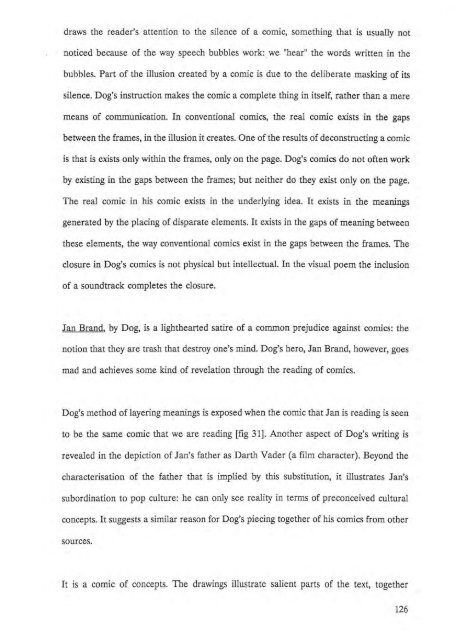Text - Rhodes University
Text - Rhodes University
Text - Rhodes University
You also want an ePaper? Increase the reach of your titles
YUMPU automatically turns print PDFs into web optimized ePapers that Google loves.
draws the reader's attention to the silence of a comic, something that is usually not<br />
noticed because of the way speech bubbles work: we "hear" the words written in the<br />
bubbles. Part of the illusion created by a cornic is due to the deliberate masking of its<br />
silence. Dog's instruction makes the cornic a complete thing in itself, rather than a mere<br />
means of communication. In conventional cornics, the real cornic exists in the gaps<br />
between the frarnes, in the illusion it creates. One of the results of de constructing a cornic<br />
is that is exists only within the frames, only on the page. Dog's cornics do not often work<br />
by existing in the gaps between the frames; but neither do they exist only on the page.<br />
The real cornic in his cornic exists in the underlying idea. It exists in the meanings<br />
generated by the placing of disparate elements. It exists in the gaps of meaning between<br />
these elements, the way conventional cornics exist in the gaps between the frames. The<br />
closure in Dog's cornics is not physical but intellectual. In the visual poem the inclusion<br />
of a soundtrack completes the closure.<br />
Jan Brand, by Dog, is a lighthearted satire of a common prejudice against cornics: the<br />
notion that they are trash that destroy one's mind. Dog's hero, Jan Brand, however, goes<br />
mad and achieves some kind of revelation through the reading of cornics.<br />
Dog's method of layering meanings is exposed when the cornic that Jan is reading is seen<br />
to be the same cornic that we are reading [fig 31]. Another aspect of Dog's writing is<br />
revealed in the depiction of Jan's father as Darth Vader (a film character). Beyond the<br />
characterisation of the father that is implied by this substitution, it illustrates Jan's<br />
subordination to pop culture: he can only see reality in terms of preconceived cultural<br />
concepts. It suggests a similar reason for Dog's piecing together of his comics from other<br />
sources.<br />
It is a comIC of concepts. The drawings illustrate salient parts of the text, together<br />
126
















